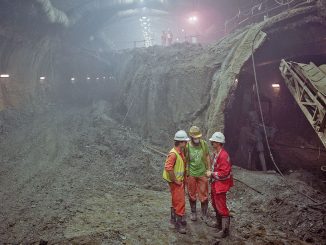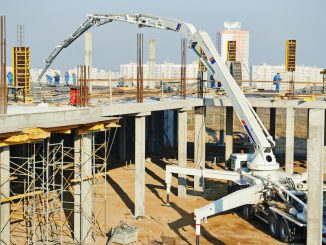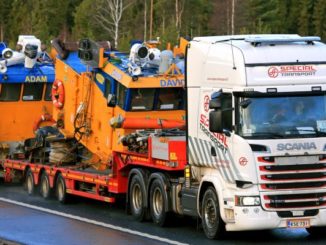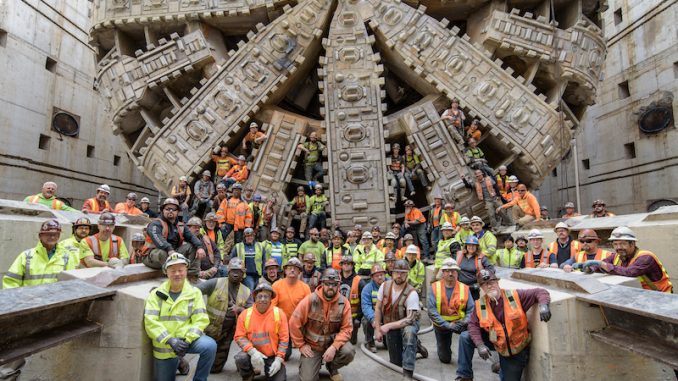
View the complete article, including interview, here.
Big construction requires big ideas, big money — and mammoth equipment. The Washington State Department of Transportation (WSDOT) proposed a project back in 2009 to replace the Alaskan Way Viaduct with the State Road 99 (SR 99) tunnel.
Their big idea was to dig a tunnel under the city of Seattle. The equipment needed to do this didn’t exist.
WSDOT needed a tunnel boring machine (TBM) massive enough to breakthrough 1.7 miles of rock and soil 200 feet below a populous city. A Japanese company, Hitachi Zosen Sakai Works, built the machine that was ultimately named after the 1920s Seattle first female mayor Bertha Knight Landes.
The TBM measured 57.5 feet in diameter and weighed nearly 8,000 tons. The 326-foot long TBM cost more than $80 million to build.
Before Bertha, “Becky” was the biggest and baddest TBM around. She was used to divert part of the Niagara River to a hydroelectric plant in Canada. Becky had a 45-foot cutting head and weighed “just” 4,000 tons.
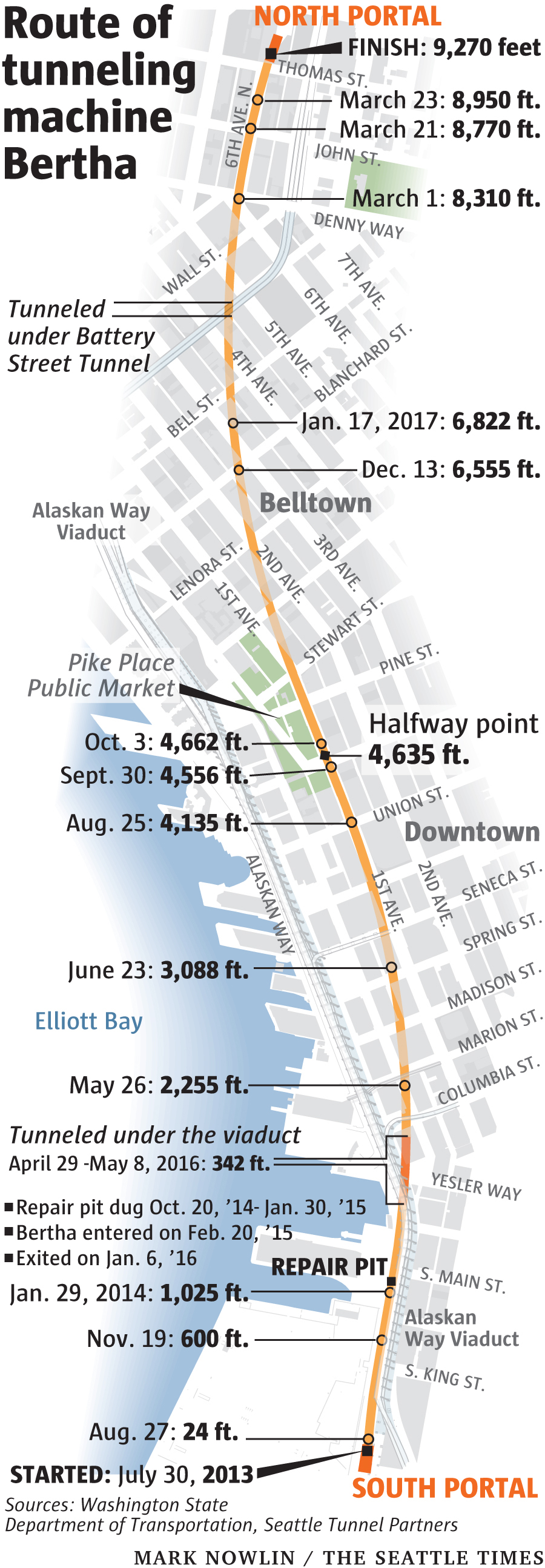 The Fabulous Fifties
The Fabulous Fifties
The big idea to solve Seattle’s growing traffic problem started in the mid-1930s. It was the Alaskan Way Viaduct.
In early 1950, work began on the viaduct. It opened to traffic in 1953. By 1959, the Battery Street Tunnel and an extension to the viaduct were completed.
A 3.4-mile-long freeway was built south of the West Seattle Bridge and headed north to the downtown waterfront.
The freeway begins as a standard surface road and ramps up to a double-decker viaduct that comprises about half of the thoroughfare. The upper tier runs north; the lower tier runs south.
Eventually, traffic moves into the Battery Street Tunnel. With the tunnel, the total route is 3.8 miles. It is a relatively short way to travel, but incredibly complex.
The 2001 Earthquake Reveal
There’s nothing like a natural disaster to reveal the flaws in a structure. In 2001, the magnitude 6.8 Nisqually earthquake damaged the viaduct.
Warnings from engineers in the 1990s that the viaduct would likely not withstand a 7.5 magnitude quake were not treated with urgency.
Years were spent debating whether to repair, replace, or eliminate the viaduct. Way before Nisqually, the roadways in and out of downtown Seattle were stressed by increasing traffic.
When the viaduct was built in the 1950s, it was estimated that 65,000 cars a day would travel on its roadways. In the early 2000s, it was handling an average of 110,000 cars a day.
In contrast, the SR 99 tunnel can handle about a 9.0 magnitude earthquake. All equipment in the tunnel has gone through a seismic analysis.
Geotechnical and structural engineers agree that being in the tunnel during an earthquake is your safest bet as the seismic waves are greatest above the surface.
Tunnels, with the help of the joints between its rings, move with the soil while above-ground structures sway to and fro. Moreover, when the earthquake is over, the tunnel will remain watertight. This allows people to safely evacuate.
The completed SR 99 tunnel is the largest double-deck highway tunnel of its kind in the country.
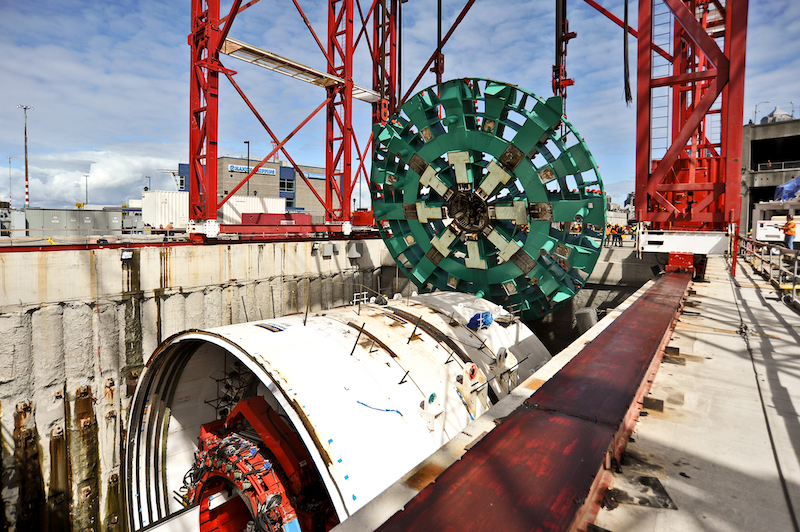
Back to Bertha
Because of her size, Bertha, built in Japan, could not be shipped to the United States fully-assembled. In April 2013, Bertha arrived in 41 pieces and was reassembled at the bottom of an 80-foot deep, concrete-lined pit on the waterfront.
However, the giant cutterhead weighing 944 tons had to be shipped in one piece, requiring one of the largest ships in the world.
Bertha is deceiving from the outside. Inside, she has catwalks, ladders, and stairs. There is a control room and even a pair of break rooms.
Bertha is highly automated — it only takes about two dozen workers to keep her moving. But it takes thousands of feet of cables and pipes to supply Bertha with the power, water, and conditioner she needs.
Bertha’s cutterhead covers the entire front of the machine. It has hundreds of steel teeth that break up the dense glacial soil and boulders encountered along the tunnel route.
The soil moves through gaps inside the cutterhead. Some teeth rotate so that the right tooth is matched with the right task, such as grinding up big boulders.
The cutterhead rotates up to 1.2 rpm using a 18,600-kW electrical system. The machine moves approximately 35 feet a day.
How much water is in the soil affects Bertha’s ability to move forward. If there isn’t enough water, the machine can break up the soil by injecting it with a mix of water and a soapy conditioner.
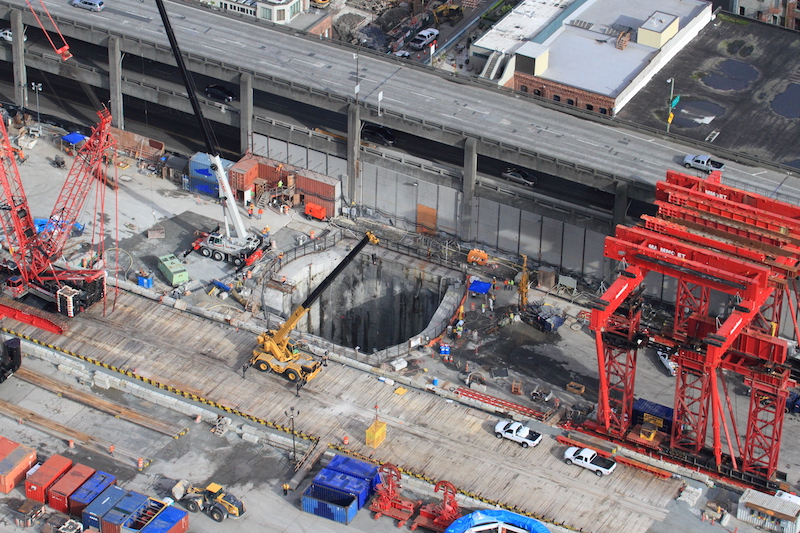
A Challenging Environment
Although Bertha didn’t have to bore through solid rock, the environment was diverse. Over hundreds of thousands of years, Seattle developed in such a way that eight types of soil formed the ground under the city center.
She had to bore her way through 10 geological zones and come out of a hillside where the soil is very dry.
It gets worse. After well over a century of building, Seattle was a tangle of foundations, pilings, cellars, and sewage lines. Not to mention railway, road, and pedestrian tunnels.
Bertha could not begin her journey until old deposits of fill soils were removed. Areas were strengthened so Bertha could do her work without destroying everything around her.
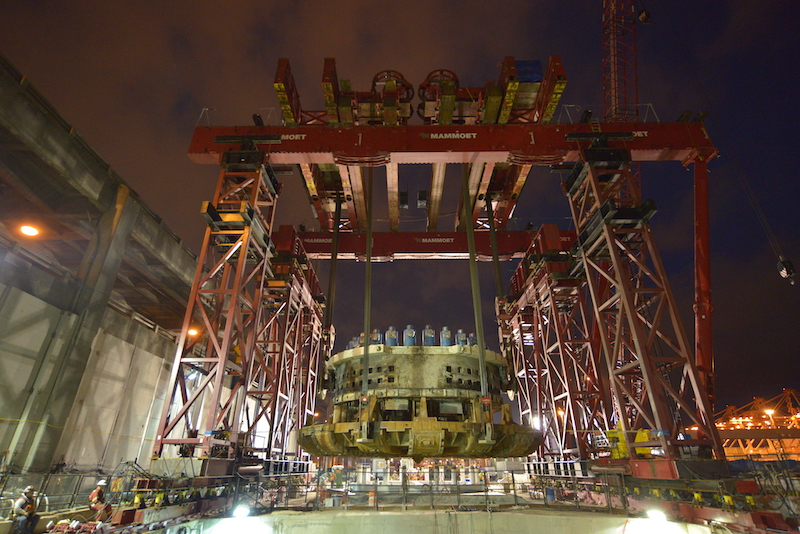
Under Pressure
For Bertha to move the excavated soil to where it belonged, the cutterhead was pressurized up to 5.6 atmospheres. This kept the soil slurry in the cutterhead until it was removed.
The amount of pressure had to be enough to keep slurry from churning away inside the cutterhead and causing the front face of the tunnel to fall in.
With too much pressure, the machine would push a bunch of slurry ahead of itself.
The pressure had to be maintained. When the cutterhead needed to be serviced, workers dove through an airlock and worked inside a pressurized bubble within the cutterhead.
This huge TBM used a 3-foot diameter steel tube to allow the slurry to move safely through it via an Archimedean screw onto a conveyor belt. This tiny tube prevented the slurry from blasting into the digging machine with five atmospheres of pressure behind it.
The soil was moved by conveyer belt out the tunnel and onto a nearby barge.
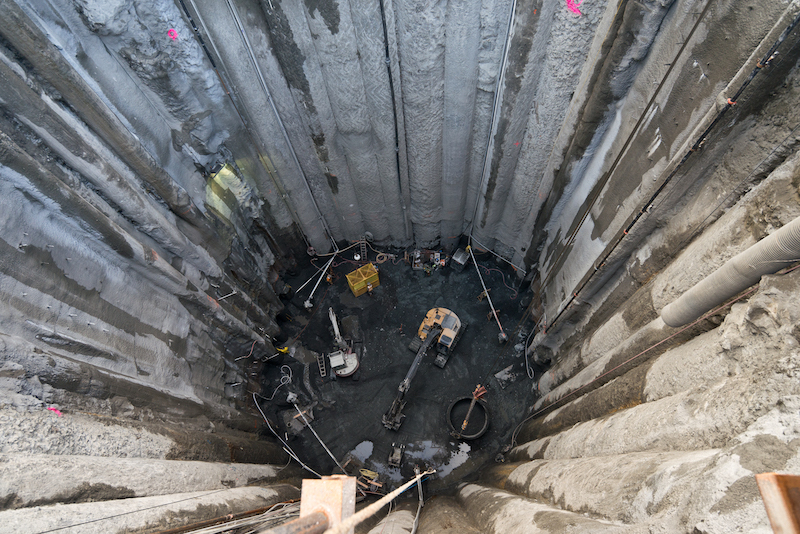
To Shield and Protect
Bertha’s shield was part of her power. The cylindrical hull at the front of the TBM protected her tunnel-building equipment and the workers inside.
Underneath the shield, the tunnel rings were assembled one at a time, using powerful suction vacuums to lift ten segments off a truck, take them through the machine and move them into place. Each segment was two-and-a half-feet thick and weighed 36,000 pounds. A completed ring weighed an astounding 360,000 pounds.
After a ring was assembled and bolted into place, 56 hydraulic jacks then pushed the machine forward 6.5 feet- leaving exactly enough space to build the next tunnel ring. It took 1,427 rings to build the 1.7 mile bored section of the 2-mile long tunnel.
Inside the machine, workers monitored and guided Bertha using a laser-guided system to stay exactly on the tunnel path.
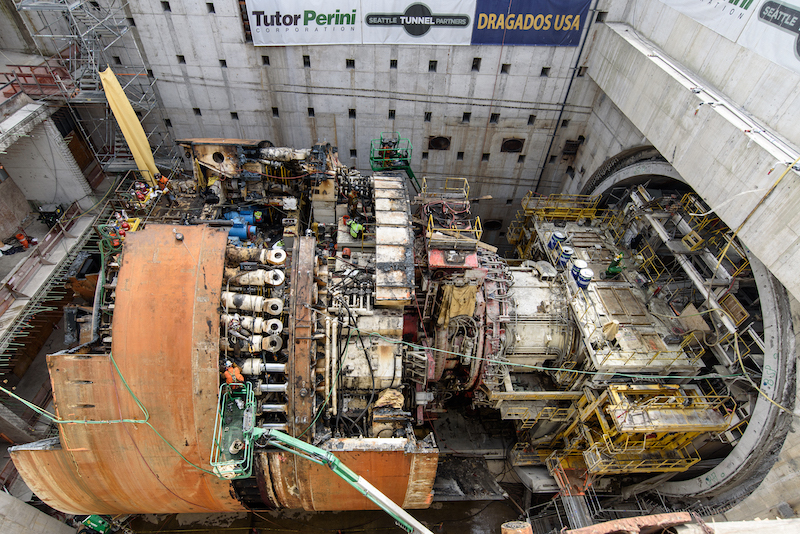
Working Inside a Giant Machine
The SR 99 project has required legions of workers representing many disciplines from truck drivers to engineers.
In a project this complex, it’s critical to account for every person. Before starting their shift, each worker picked up a metal tag that tracked their entering and leaving the tunnel.
During the time Bertha was tunneling, she would push forward, and then stop to build the outer wall. This was done one ring at a time.
A tunnel ring is comprised of 10 segments, each weighing about 18 tons. An enormous suction vacuum lifted and placed each segment.
It literally played a different tune while in motion to alert nearby workers. Each segment was leveled with a hand tool and secured using a bolt and drill.
Employee restrooms and a kitchen were located inside Bertha’s trailing gear, which rested on huge rollers.
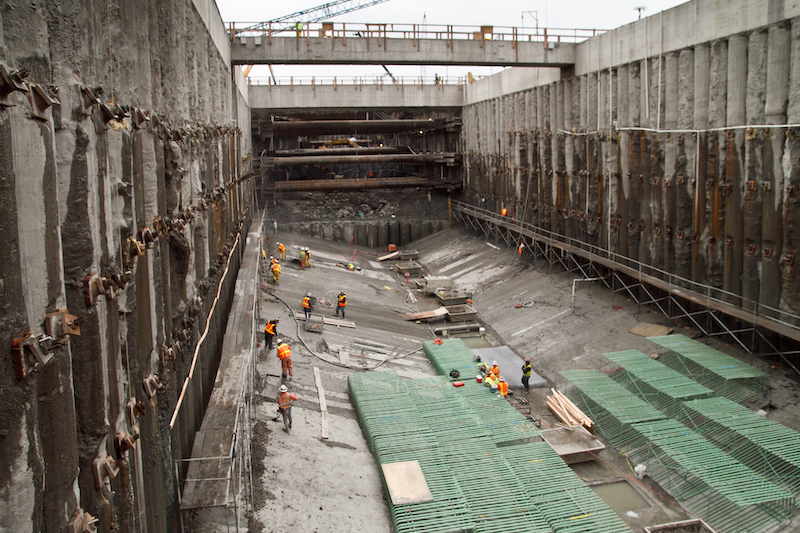
What Could Stop Bertha?
Bertha started boring in July 2013 with an estimated completion date for the tunnel of December 2015.
Then, in December 2013, with only 10 percent of the tunnel built, the machine overheated and stopped moving forward.
After months of investigation, Seattle Tunnel Partners (STP), the design-build contractor on the tunnel project, discovered that the seals designed to protect the main bearing were badly damaged.
STP and machine-manufacturer Hitachi Zosen developed an unprecedented plan to rescue and repair the machine by pulling the five-story-tall cutterhead and drive unit up from below.
This required construction of a 120-foot deep, 85-foot-wide shaft in a tight, soggy work zone next to the viaduct the tunnel was supposed to replace.
Crews built large, interlocking concrete piles to create the wall of the rescue pit.
The Dutch lift company Mammoet was brought in to design and build a custom crane more than 50 feet tall and able to lift 2,400 tons.
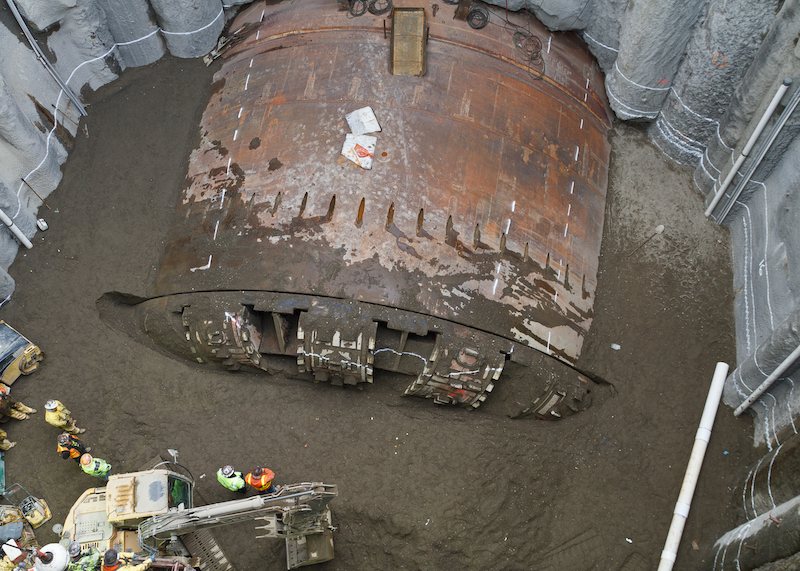
The tower gantry planned for the operation was to rest on piles previously built to stabilize the viaduct. But the piles were not designed to support millions of pounds of downward pressure.
Uneven distribution could destabilize the tower gantry. The design of the gantry was in some ways as innovative as Bertha herself. It could slide and tilt lifted objects.
To evenly disperse the load, 48 hydraulic cylinders were used. It was the first gantry fully supported by hydraulics.
A full two years were spent in the repair process. Finally, in December 2015, work resumed.
Soon after, the project was delayed again when a tethered barge in Elliott Bay damaged nearby piers. Seattle is located on Elliott Bay as is the Port of Seattle.
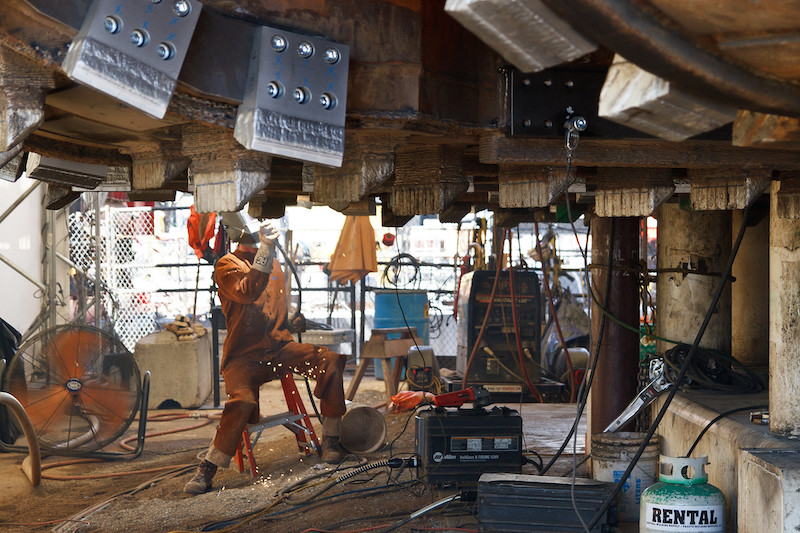
The barge, loaded with excavated dirt, started to lean over. To avoid damaging the conveyer that moves the dirt from the tunnel to the dock, workers set the barge adrift. The barge hit a nearby pier and terminal, which damaged the barge and the dock. To make things really interesting, a sinkhole opened up near the site.
All tunnel work was halted a second time in January 2016. Ultimately, citing safety concerns, Washington Governor Jay Inslee ordered work stopped for a review of all operational and safety procedures. Work resumed a couple of months later and Bertha completed tunnel boring in April 2017.
Replacing the viaduct with the tunnel is just the first step in a much larger construction project.
Removing the Alaskan Way Viaduct
The Alaskan Way Viaduct must be removed. It was old and did not meet seismic codes in this earthquake-prone region. Replacing it was a public safety issue. Its removal paves the way for Seattle’s Waterfront Program.
Removal of the viaduct began in February 2019 and is expected to take several months. (Track the project’s progress here.)
Once the viaduct removal is complete, the area will be restored and turned over to the city of Seattle’s Waterfront Seattle Program.
In addition to the demolition of the viaduct, the old Battery Street Tunnel will be filled in and sealed and new surface streets built in place of the old tunnel entrance.
The viaduct is being removed frame-by-frame beginning with the upper deck.
Crews will use impact hammers to remove the roadway deck. Then, hydraulic munchers will remove the supporting girders and columns. Some pieces of the viaduct closest to buildings will be saw-cut and then lifted and removed with cranes. Finally, the viaducts foundations will be removed and the site restored.
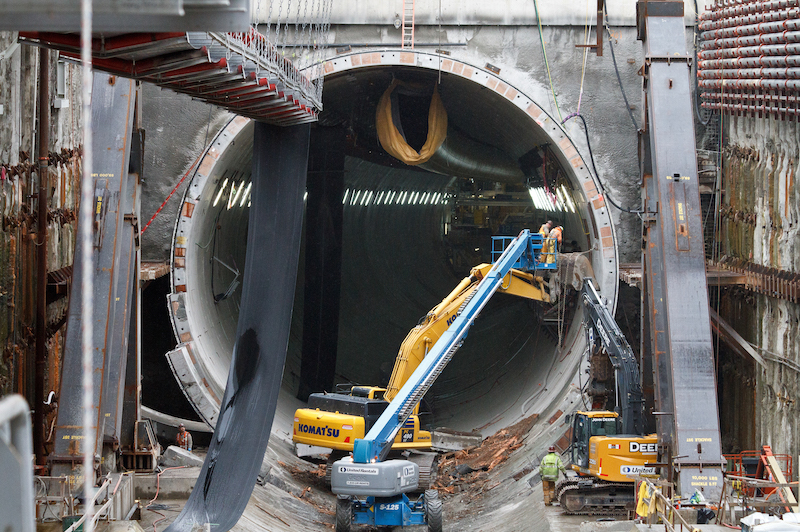
The (Now) Mighty Seawall
The original seawall was built with 20,000 old-growth timber piles along Seattle’s waterfront between 1916 and 1934. Over time, these timber piles disintegrated. The Seattle Seawall Project rebuilt the structure.
Although the new seawall is designed to withstand earthquakes and tsunamis, the SR 99 tunnel has a backup plan. Should a tsunami take place during very high tide (an event likely to occur only once in 6,000 to 24,000 years), Washington state’s early warning system and the tunnel’s real-time traffic technology kick in.
Vehicles will be stopped from entering the tunnel. Drains and pumps will immediately remove any water from within the tunnel at a rate of 300 gallons per minute.
Safe and Sound
In the rare event of an evacuation, the SR 99 tunnel has doors every 650 feet leading out to safe areas to either take cover or exit the tunnel. There is a pathway that runs along the entire tunnel equipped with ventilation and fire suppression systems. 300 cameras provide tunnel operators with real-time information 24/7.
The roadways have eight-foot wide shoulders, allowing ample space for vehicles to safely pull over in the case of an emergency. It also provides a pathway for emergency vehicles.
The tunnel itself is environmentally friendly. Three different types of fans keep fresh air flowing through the tunnel. They remove fumes from engines. In fact, it’s the vehicles themselves that push fresh air through the tunnel. Monitoring stations can detect increasing particulates in the air and jet fans are automatically activated to provide additional air flow.
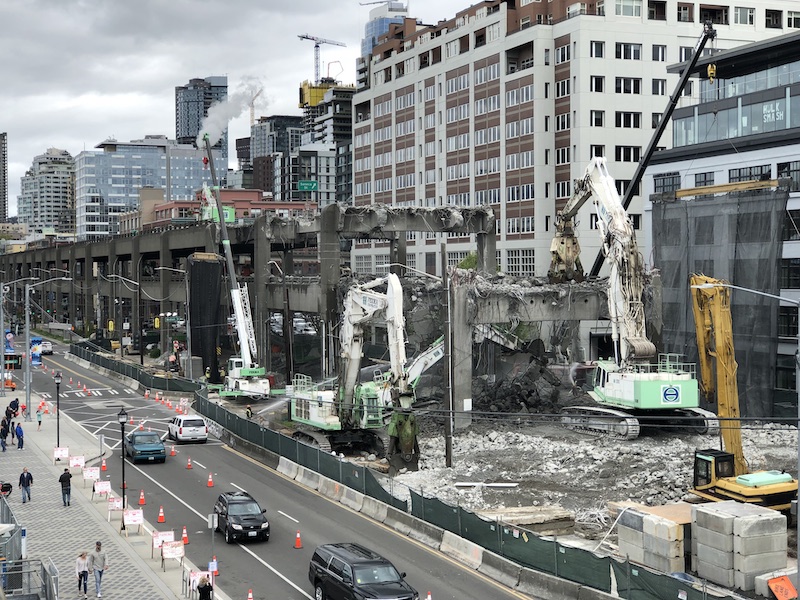
In Case of Emergency
If there is a fire, eight huge extraction fans pull smoke out through vents in the tunnel wall. Simultaneously, the jet fans push fresh air inside. Smoke is ultimately pushed out of the tunnel’s ventilation stacks on top of the operations buildings located at both ends of the tunnel.
Maintenance fans provide pressurization to prevent smoke from engulfing the tunnel’s emergency exit area.
The emergency walkways have their own ventilation and fire control systems. These run parallel to both the upper and lower tunnel roadways.
Concrete walls and fire-resistant doors keep the emergency areas separate from the roadways. For those travelers who cannot use the stairwells to escape, there are “refuge” areas that will accommodate them. Emergency phones and cameras allow first responders to help those waiting in the refuge areas.
Should there be a power failure, generators power critical tunnel systems.
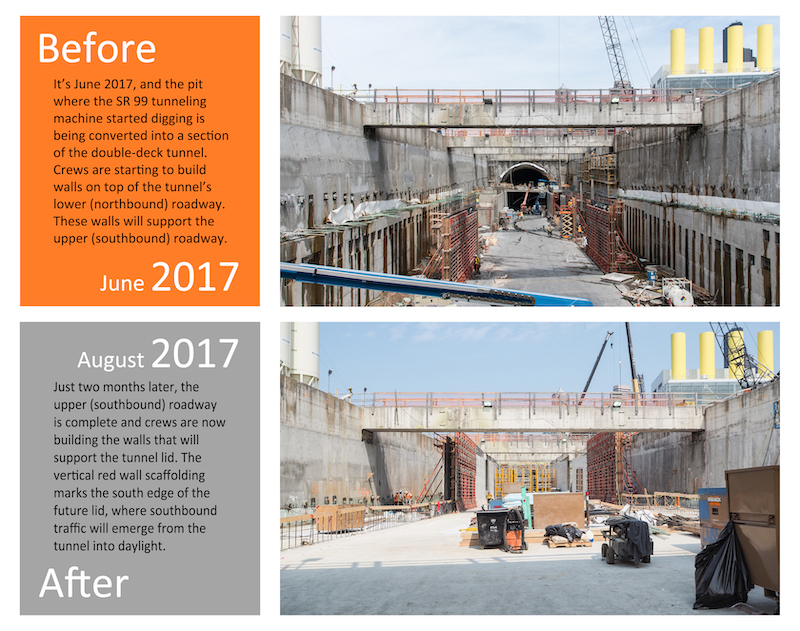
The Work is Never Done
Completion of the SR 99 tunnel is just the beginning. There is a lot more work to be done.
Closing the Battery Street Tunnel
The mechanical and electrical systems were removed. Now contractor Kiewit will fill the old Battery Street Tunnel with the concrete rubble from the viaduct demolition.
Steel rebar was removed from the rubble and the concrete was crushed into small pieces. Funnels are used to send the rubble inside the tunnel. A vibratory roller is used to compact the fill. The tunnel will not be completely filled up — about seven feet of space will be left at the top.
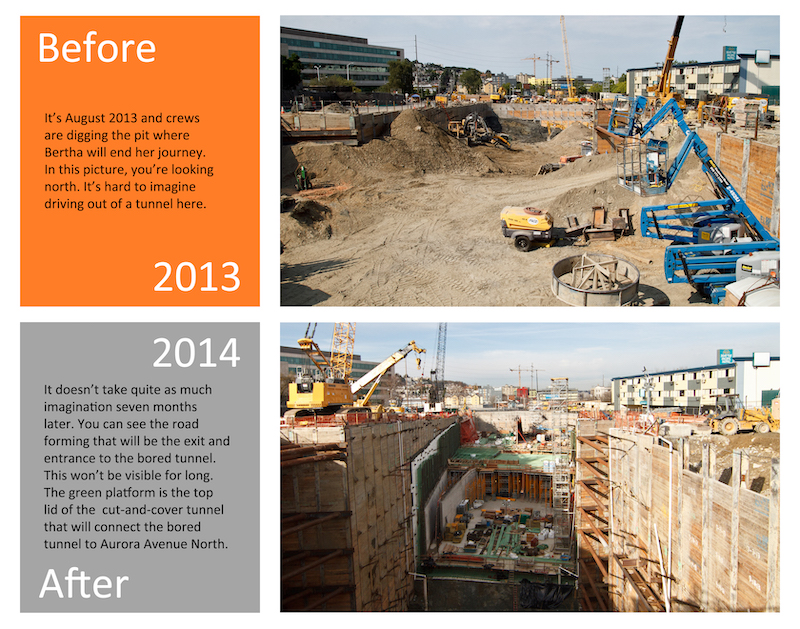
On the Waterfront
The waterfront above the tunnel should be more peaceful. A promenade 12- to 40-feet wide will be built and beautified with trees and flowers.
Visitors can safely ride on a private bike trail. Overlook Walk is a public path that will connect the waterfront to Pike Place Market. It will provide expansive views of Elliott Bay and the city skyline. (See a complete list of projects, budget, and schedule: https://waterfrontseattle.org/budget-schedule.)
Pay Day
Later this year, tolling will start for users of the SR 99 tunnel. Tolls will help pay off the construction bonds and fund operations and maintenance. While tolling is expected to reduce tunnel use, over time, WSDOT expects traffic will grow as the tunnel provides a quick trip through an often-crowded downtown Seattle.
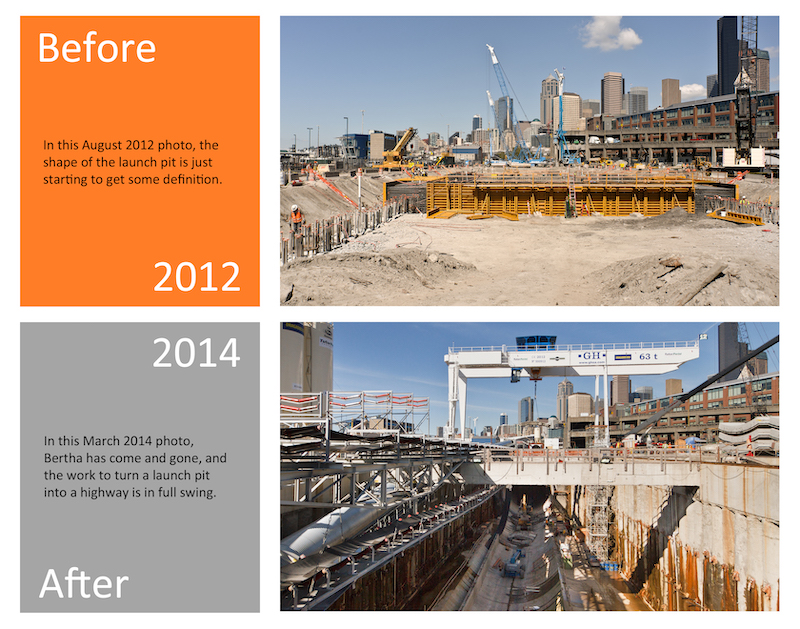
Dismantling a Giant
When her work was done in 2017, Bertha was broken up into pieces that would never again be reassembled.
The cutting disc was carved into eight sections. Then each section was chopped into smaller pieces to be under the 20-ton maximum weight allowable to haul her away truckload-by-truckload on Seattle’s city streets.
In order to ensure a balanced lift, engineers located the center of mass for each steel slice to determine where fastening loops should be attached.
Using torches, scaffolds, and power tools, it took months to dismantle Bertha.
As much of Bertha as possible will be re-used, including 24 electric motors, movable arms, and miles of hoses, wires, and conveyer belts. The rest of Bertha will be melted down and recycled. The remaining pieces of her cutting head were taken to a scrap-metal yard. The Port of Seattle held onto a few chunks to display to the public.
Lessons Learned
Despite delays and a small cost overrun of about 5 percent, the SR 99 tunnel project can certainly be called a success. On-site innovations by equipment manufacturers, engineers, and workers will improve the way large construction projects are handled in the future.
View the complete article, including interview, here.
What caused the delay in Bertha's tunneling process, and how was it addressed?
Bertha faced a delay in December 2013 due to damaged seals protecting the main bearing, leading to an unprecedented plan involving pulling the cutterhead up from below for repairs.
How does the SR 99 tunnel address safety concerns, particularly during emergencies?
The SR 99 tunnel ensures safety with features like emergency walkways, ventilation systems, refuge areas, and environmental measures, making it well-prepared for scenarios such as fires, power failures, or evacuations.






































